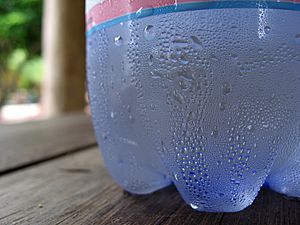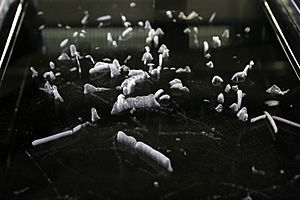Condensation facts for kids

Condensation is a cool process where a gas changes into a liquid. This happens when the gas touches something cooler. It's like magic, but it's science! Condensation is a super important part of the water cycle on Earth. It's the opposite of evaporation, which is when a liquid turns into a gas.
Contents
How Condensation Works
When water condenses, it changes from a gas (like water vapor) into a liquid or even tiny crystals of ice. Any gas can condense. This usually happens when the gas gets very cold or is under high pressure.
Think of it like this: the tiny molecules in the gas are zipping around super fast. When they cool down, they slow down a lot. As they slow down, they get closer together and change into a liquid. Heat energy is actually taken away during this process, which causes the change.
Condensation is a big deal in nature. It's always linked to temperature and how much vapor is in the air. If there's a lot of condensation, the temperature around it can actually go up. If there's hardly any condensation, the temperature might go down.
This process is really useful! For example, it helps create "new water" that we can drink from different sources.
Where Condensation Starts
Condensation often starts when tiny groups of molecules form in the gas. Imagine how rain drops or snow flakes form inside clouds. It's similar! This can also happen when gas touches a liquid or solid surface.
In clouds, tiny proteins from microbes in the air can help water molecules stick together. These proteins act like tiny magnets, pulling water vapor molecules to them to start the condensation.
Common Ways Condensation Happens
Condensation often happens when a vapor is cooled down. It can also happen when the vapor is squeezed (compressed). This makes the gas reach its "dew point". The dew point is the temperature where the gas can't hold any more water vapor.
Machines that cool and squeeze vapor to collect the liquid are called "condensers." You might find them in air conditioners or refrigerators.
Cool Uses for Condensation

Condensation is super important in distillation. This is a process used in labs and factories to separate liquids. For example, it's used to make pure water or different types of alcohol.
Since condensation happens naturally, we can use it to get lots of water for people to use. Some special structures are built just to collect water from condensation. These include air wells and fog fences. These systems can even help keep soil moist in dry areas where desertification is happening. Some groups teach people in these areas how to build water condensers to help them.
Condensation is also key in cloud chambers. These are cool devices that let scientists see tiny particles. When a particle zips through, it leaves a trail of condensed vapor, like a mini cloud!
You'll find condensation used in many everyday things too. It helps generate power, clean salty water (desalination), manage heat, and is key in refrigerators and air conditioners.
Animals and Plants Using Condensation
Many living things use water that comes from condensation. For example, the Australian thorny devil lizard collects dew on its skin. The darkling beetles in the Namibian desert also get water from fog. Even the giant coast redwoods in the West Coast of the United States get moisture from fog and condensation.
Condensation in Buildings
Condensation inside buildings is usually not a good thing. It can cause dampness, mold health issues, and even make wood rot. It can also lead to corrosion of metal and weaken walls. Plus, it can waste energy because heat escapes more easily.
To stop this, you need to lower the humidity inside. Or, you can improve how air moves through the building. Simple ways to do this include opening windows or using extractor fans. You can also use dehumidifiers, dry clothes outside, and cover pots when cooking.
Air conditioning or ventilation systems can also help remove moisture from the air. They also move air around a building. Warmer air can hold more water vapor. But, this can be tricky. Most condensation at home happens when warm, moist air touches a cold surface. As the air cools, it can't hold as much water. This causes water to form on the cold surface. You see this a lot in winter when warm indoor air meets cold, single-pane windows.
Sometimes, condensation can happen inside walls or roofs. This can be due to poor insulation or gaps that let cold air in.
See also
 In Spanish: Condensación (cambio de estado) para niños
In Spanish: Condensación (cambio de estado) para niños




